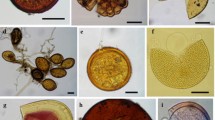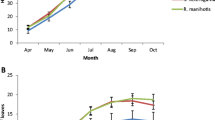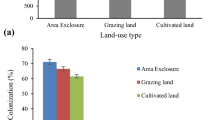Abstract
Nontimber forest products (NTFPs) represent an important source of income to millions of people in tropical forest regions, but some NTFP species have decreased in number and become endangered due to overexploitation. There is increasing concern that the planting stocks of Dyera polyphylla and Aquilaria filaria are not sufficient to sustain the yield of NTFPs and promote forest conservation. The objective of this study was to determine the effect of two arbuscular mycorrhizal (AM) fungi, Glomus clarum and Gigaspora decipiens, on the early growth of two NTFP species, D. polyphylla and A. filaria, under greenhouse conditions. The seedlings of both species were inoculated with G. clarum or G. decipiens, or uninoculated (control) under greenhouse conditions. Percentage of AM colonization, plant growth, survival rate, and nitrogen (N) and phosphorus (P) concentrations were measured after 180 days of growth. The percentage of AM colonization of D. polyphylla and A. filaria ranged from 87 to 93% and from 22 to 39%, respectively. Colonization by G. clarum and G. decipiens increased plant height, diameter, and shoot and root dry weights. Shoot N and P concentrations of the seedlings were increased by AM colonization by as much as 70–153% and 135–360%, respectively. Survival rates were higher in the AM-colonized seedlings at 180 days after transplantation than in the control seedlings. The results suggest that AM fungi can accelerate the establishment of the planting stocks of D. polyphylla and A. filaria, thereby promoting their conservation ecologically and sustaining the production of these NTFPs economically.


Similar content being viewed by others
References
Alexander I, Ahmad N, See LS (1992) The role of mycorrhizas in the regeneration of some Malaysian forest trees. Philos Trans R Soc Lond B Biol Sci 335:379–388
Brundrett M, Bougher N, Dell B, Grove T, Malajczuk N (1996) Working with mycorrhizas in Forestry and Agriculture. ACIAR Monograph 32, Canberra
CITES (2005) Convention on international trade in endangered species of wild fauna and flora (Appendices I, II and III). UNEP, p 48
Ding Hou (1960) Thymelaeaceae. In: Van Steenis CGGJ (ed) Flora Malesiana, vol. 6, series 1. Wolters-Noordhoff, Groningen, The Netherlands, pp 1–15
Donovan DG, Puri RK (2004) Learning from traditional knowledge of non-timber forest products: Penan Benalui and the autecology of Aquilaria in Indonesian Borneo. Ecol Soc 9:1–23
Giovannetti M, Mosse B (1980) An evaluation of techniques for measuring vesicular-arbuscular mycorrhizal infection in roots. New Phytol 84:489–500
Guadarrama P, Álvarez-Sánchez J, Briones O (2004) Seedling growth of two pioneer tropical tree species in competition: the role of arbuscular mycorrhizae. Euphytica 138:113–121
Huat OK, Awang K, Hashim A, Majid NM (2002) Effects of fertilizers and vesicular-arbuscular mycorrhizas on the growth and photosynthesis of Azadirachta excelsa (Jack) Jacobs seedlings. For Ecol Manag 158:51–58
Janos DP (1980) Vesicular–arbuscular mycorrhizae affect lowland tropical rain forest plant growth. Ecology 61:151–162
Jasper DA, Davy JA (1993) Root characteristics of native plant species in relation to the benefit of mycorrhizal colonisation for phosphorus uptake. Plant Soil 155/156:281–284
Kashyap S, Sharma S, Vasudevan P (2004) Role of bioinoculants in development of salt-resistant saplings of Morus alba (var. sujanpuri) in vivo. Sci Hortic 100:291–307
Kiers ET, Lovelock CE, Krueger EL, Herre EA (2000) Differential effects of tropical arbuscular mycorrhizal fungal inocula on root colonization and tree seedling growth: implications for tropical forest diversity. Ecol Lett 3:106–113
Kobayashi S (2004) Landscape rehabilitation of degraded tropical forest ecosystems. Case study of the CIFOR/Japan project in Indonesia and Peru. For Ecol Manag 201:13–22
Lemmens RHMJ, Soerianegara I, Wong WC (eds) (1998) Timber trees: minor commercial timbers. Plant Resources of South-East Asia, No. 5 (2), Prosea, Bogor, Indonesia
Manjunath A, Habte M (1991) Root morphological characteristics of host species having distinct mycorrhizal dependency. Can J Bot 69:671–676
Moyersoen B, Alexander IJ, Fitter AH (1998) Phosphorus nutrition of ectomycorrhizal and arbuscular mycorrhizal tree seedlings from a lowland tropical rain forest in Korup National Park, Cameroon. J Trop Ecol 14:47–61
Moyersoen B, Becker P, Alexander IJ (2001) Are ectomycorrhizas more abundant than arbuscular mycorrhizas in tropical heath forests? New Phytol 150:591–599
Muthukumar T, Udaiyan K, Rajeshkannan V (2001) Response of neem (Azadirachta indica A. Juss) to indigenous arbuscular mycorrhizal fungi, phosphate-solubilizing and asymbiotic nitrogen-fixing bacteria under tropical nursery conditions. Biol Fertil Soils 34:417–426
Olsen SR, Sommers LE (1982) Phosphorus. In: Page AL (ed) Methods of soil analysis. Part 2. Chemical and microbiological properties. American Society of Agronomy, Madison, pp 403–430
Oyen LPA, Dung NX (eds) (1999) Essential-oil plants. Plant Resources of South-East Asia, No. 19, Prosea, Bogor, Indonesia
Pope PE, Chaney WR, Rhodes JD, Woodhead SH (1983) The mycorrhizal dependency of four hardwood tree species. Can J Bot 61:412–417
Smits WTM (1994) Dipterocarpaceae: mycorrhizae and regeneration. Backhuys, AH Leiden, The Netherlands
Soehartono T, Newton AC (2000) Conservation and sustainable use of tropical trees in the genus Aquilaria I. Status and distribution in Indonesia. Biol Conserv 96:83–94
Tawaraya K, Takaya Y, Turjaman M, Tuah SJ, Limin SH, Tamai Y, Cha JY, Wagatsuma T, Osaki M (2003) Arbuscular mycorrhizal colonization of tree species grown in peat swamp forests of Central Kalimantan, Indonesia. For Ecol Manag 182:381–386
Weber HC, Klahr A, MarronHeimbuch M (1995) Anatomical structures of the VA mycorrhiza in the Apocynaceae (Gentianales). Bot Acta 108:525–534
Zandavalli RB, Dillenburg LR, de Souza PVD (2004) Growth responses of Araucaria angustifolia (Araucariaceae) to inoculation with the mycorrhizal fungus Glomus clarum. Appl Soil Ecol 25:245–255
Acknowledgements
This research was supported in part by the Core University Program of Japan Society for the Promotion of Science (JSPS) and a Grant-in-Aid for Scientific Research from the JSPS (No. 16208032).
Author information
Authors and Affiliations
Corresponding author
Rights and permissions
About this article
Cite this article
Turjaman, M., Tamai, Y., Santoso, E. et al. Arbuscular mycorrhizal fungi increased early growth of two nontimber forest product species Dyera polyphylla and Aquilaria filaria under greenhouse conditions. Mycorrhiza 16, 459–464 (2006). https://doi.org/10.1007/s00572-006-0059-4
Received:
Accepted:
Published:
Issue Date:
DOI: https://doi.org/10.1007/s00572-006-0059-4




